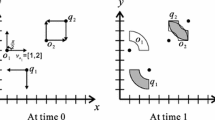Abstract
Consider a collection of entities moving with bounded speed, but otherwise unpredictably, in some low-dimensional space. Two such entities encroach upon one another at a fixed time if their separation is less than some specified threshold. Encroachment, of concern in many settings such as collision avoidance, may be unavoidable. However, the associated difficulties are compounded if there is uncertainty about the precise location of entities, giving rise to potential encroachment and, more generally, potential congestion within the full collection.
We adopt a model in which entities can be queried for their current location (at some cost) and the uncertainty region associated with an entity grows in proportion to the time since that entity was last queried. The goal is to maintain low potential congestion, measured in terms of the (dynamic) intersection graph of uncertainty regions, using the lowest possible query cost. Previous work, in the same uncertainty model, described query schemes that minimize several measures of congestion potential for point entities, using location queries of some fixed frequency. These schemes were shown to be O(1)-competitive, with other, even clairvoyant query schemes (that know the trajectories of all entities), subject to the same bound on query frequency.
In this paper we design a scheme that is competitive in terms of its query granularity (minimum spacing between queries), over all sufficiently large time intervals, while guaranteeing a fixed bound on collision potential (defined as the maximum degree of the intersection graph of uncertainty regions), for entities with positive extent. Our complementary optimization objective necessitates surprisingly different algorithms and analyses from that in previous work. Nevertheless, we also show that the competitive factor of our scheme is best possible, up to a constant factor, in the worst case.
This work was funded in part by Discovery Grants from the Natural Sciences and Engineering Research Council of Canada.
Access this chapter
Tax calculation will be finalised at checkout
Purchases are for personal use only
Similar content being viewed by others
References
Anily, S., Glass, C.A., Hassin, R.: The scheduling of maintenance service. Discret. Appl. Math. 82, 27–42 (1998)
Basch, J., Guibas, L.J., Hershberger, J.: Data structures for mobile data. J. Algorithms 31(1), 1–28 (1999)
Busto, D., Evans, W., Kirkpatrick, D.: Minimizing interference potential among moving entities. In: Proceedings of the ACM-SIAM Symposium on Discrete Algorithms (SODA), pp. 2400–2418 (2019)
de Berg, M., Roeloffzen, M., Speckmann, B.: Kinetic compressed quadtrees in the black-box model with applications to collision detection for low-density scenes. In: Epstein, L., Ferragina, P. (eds.) ESA 2012. LNCS, vol. 7501, pp. 383–394. Springer, Heidelberg (2012). https://doi.org/10.1007/978-3-642-33090-2_34
de Berg, M., Roeloffzen, M., Speckmann, B.: Kinetic convex hulls, Delaunay triangulations and connectivity structures in the black-box model. J. Comput. Geom. 3(1), 222–249 (2012)
de Berg, M., Roeloffzen, M., Speckmann, B.: Kinetic 2-centers in the black-box model. In: Symposium on Computational Geometry, pp. 145–154 (2013)
Erlebach, T., Hoffmann, M.: Query-competitive algorithms for computing with uncertainty. Bull. Eur. Assoc. Theor. Comput. Sci. 2(116) (2015)
Evans, W., Kirkpatrick, D.: Frequency-competitive query strategies to maintain low congestion potential among moving entities (2023). arXiv:2205.09243
Evans, W., Kirkpatrick, D., Löffler, M., Staals, F.: Minimizing co-location potential of moving entities. SIAM J. Comput. 45(5), 1870–1893 (2016)
Fishburn, P.C., Lagarias, J.C.: Pinwheel scheduling: achievable densities. Algorithmica 34(1), 14–38 (2002)
Guibas, L.J.: Kinetic data structures: a state of the art report. In: Proceedings of the Third Workshop on the Algorithmic Foundations of Robotics on Robotics: The Algorithmic Perspective, WAFR 1998, USA, pp. 191–209. A. K. Peters Ltd. (1998)
Guibas, L.J., Roeloffzen, M.: Modeling motion. In: Toth, C.D., O’Rourke, J., Goodman, J.E. (eds.) Handbook of Discrete and Computational Geometry, chap. 53, pp. 1401–1420. CRC Press (2017)
Holte, R., Mok, A., Rosier, L., Tulchinsky, I., Varvel, D.: The pinwheel: a real-time scheduling problem. In: Proceedings of the Twenty-Second Annual Hawaii International Conference on System Sciences. Volume II: Software Track, pp. 693–702 (1989)
Kahan, S.: A model for data in motion. In: Twenty-third Annual ACM Symposium on Theory of Computing, STOC 1991, pp. 265–277 (1991)
Kahan, S.: Real-time processing of moving data. Ph.D. thesis, University of Washington (1991)
Author information
Authors and Affiliations
Corresponding authors
Editor information
Editors and Affiliations
Rights and permissions
Copyright information
© 2023 The Author(s), under exclusive license to Springer Nature Switzerland AG
About this paper
Cite this paper
Evans, W., Kirkpatrick, D. (2023). A Frequency-Competitive Query Strategy for Maintaining Low Collision Potential Among Moving Entities. In: Byrka, J., Wiese, A. (eds) Approximation and Online Algorithms . WAOA 2023. Lecture Notes in Computer Science, vol 14297. Springer, Cham. https://doi.org/10.1007/978-3-031-49815-2_2
Download citation
DOI: https://doi.org/10.1007/978-3-031-49815-2_2
Published:
Publisher Name: Springer, Cham
Print ISBN: 978-3-031-49814-5
Online ISBN: 978-3-031-49815-2
eBook Packages: Computer ScienceComputer Science (R0)




